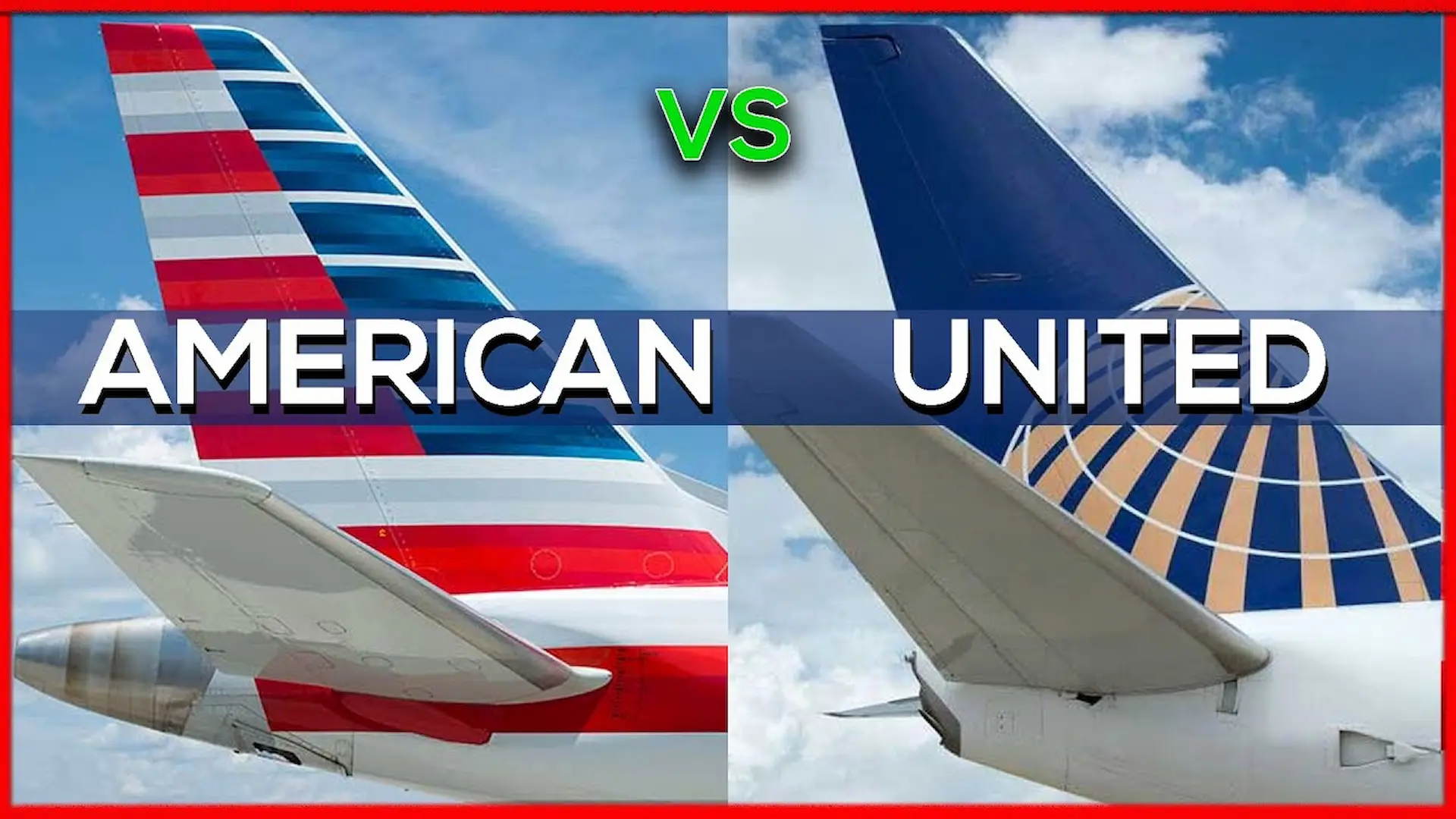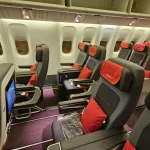Choosing between United Airlines and American Airlines isn’t simple. Both are “Big Three” U.S. carriers with vast networks, loyalty programs, and complex rules that affect your comfort, budget, and ability to earn rewards.
This guide breaks down every major factor – routes, fares, fees, reliability, loyalty programs, and in-flight perks, helping you decide which airline is best suited for your travel needs.
Fleet Size and Route Coverage: Who Has More Reach?
- Best for International Flyers: United – Star Alliance and its strength across Europe and Asia.
- Best for Latin America: American, especially via Miami hub.
- Best Basic Economy: American – carry-on allowed, same-day changes possible.
- Best Lounges: United Polaris and American Flagship both shine on long-hauls.
- Best Miles Value: American (≈ 1.3¢ per mile vs United’s ≈ 1.2¢).
- Best Elite Status for Casual Flyers: American, easier to earn via Loyalty Points.
- Best Upgrade Options: United, simpler priority mechanics.
Airline Loyalty Programs: American Airlines AAdvantage vs United MileagePlus
Loyalty programs can make a huge difference in maximizing travel rewards, upgrades, and elite benefits. Both American Airlines AAdvantage and United MileagePlus offer unique advantages, but they operate very differently, and your choice can significantly affect the value of your miles and status.
American Airlines AAdvantage
American AAdvantage is widely regarded as one of the most accessible loyalty programs for U.S. travelers who want to earn elite status without flying multiple times a week.
Key Features:
- Multiple Ways to Earn Loyalty Points: You accumulate points not only through flights but also through co-branded credit cards, partner airlines, and other eligible purchases. This makes climbing tiers like Gold, Platinum, and Executive Platinum achievable even for occasional travelers.
- Semi-Fixed Award Pricing: American uses a semi-fixed award chart to price redemptions, which keeps miles more predictable and easier to value than United’s constantly shifting system.
- Elite Benefits: Entry- and mid-level elites enjoy perks like complimentary upgrades on domestic flights, waived baggage fees, priority boarding, and access to preferred seating.
Pro Tip: For travelers who want to maximize rewards without flying every week, American’s AAdvantage program is often the better choice due to its variety of earning methods and predictable award pricing.
United Airlines MileagePlus
United MileagePlus takes a different approach, emphasizing premium upgrades and frequent flyers who travel extensively. Its program is rewarding for high-spending or elite passengers, but it comes with challenges for casual travelers.
Key Features:
- Simplified Upgrade System: United makes it relatively easy to redeem upgrades for those with elite status, especially for international flights in premium cabins.
- No Published Award Chart: Unlike American, United does not have a formal award chart, and its redemption rates are frequently adjusted. This can make award travel unpredictable and sometimes more expensive, often costing nearly twice as many miles for comparable flights.
- Elite Status Requirements: Reaching Premier 1K, United’s top tier, requires a combination of Premier Qualifying Points (PQPs) and Premier Qualifying Flights (PQFs). Specifically, you need 22,000 PQPs and 60 PQFs, which can be a significant commitment for travelers who don’t fly frequently.
- Mile Value: MileagePlus miles are valued slightly lower than AAdvantage, at around 1.2 cents per mile, reflecting their more restrictive redemption options.
Pro Tip: United MileagePlus works best for travelers who fly frequently or spend a lot on United flights, as elite perks and upgrades become more accessible and rewarding for these users.
Comparing Cabins and Fare Classes: United vs American Airlines
Understanding what each airline offers across different cabins, from economy to business—is key to choosing the right flight for your comfort, flexibility, and travel needs.
1. Basic Economy: How Restricted is It?
American Airlines Basic Economy:
- Carry-on allowance: Passengers can bring a full-size carry-on bag plus a personal item.
- Seat selection: Available for a fee; otherwise, the system automatically assigns your seat.
- Same-day changes/standby: Permitted for a fee, offering some flexibility for travelers with uncertain plans.
- Earning miles and elite points: Basic Economy passengers still accrue both, so you can continue building loyalty rewards.
- Upgrades: Not eligible for complimentary upgrades or other premium perks.
United Airlines Basic Economy:
- Carry-on restrictions: Only a personal item allowed; full-size carry-on bags are not permitted.
- Seat selection: Seats are automatically assigned at check-in; no paid selection in advance.
- Changes and cancellations: No flight changes or upgrades allowed.
- Earning miles and elite credit: Still possible, but flexibility is limited.
Traveler Tip: For travelers who prioritize flexibility, carry-on convenience, and earning miles, American Airlines Basic Economy is the more practical choice. United’s Basic Economy is stricter and better suited for budget travelers who are confident in their travel plans.
2. Main Cabin / Standard Economy: What You Get
Once you upgrade from Basic Economy to Main Cabin or Standard Economy, both airlines provide more generous benefits, but there are subtle differences:
Seat Pitch & Comfort:
- United: 30–31” standard pitch, extra legroom seats available through Economy Plus
- American: 30–31” standard pitch, extra-legroom seats available through Main Cabin Extra, often with complimentary beverages on longer flights.
Baggage Policy:
- Both airlines charge \$35 for the first checked bag and \$45 for the second on domestic flights.
- Elite members or credit card holders can waive these fees.
Seat Selection:
- United: Offers paid upgrades to Economy Plus for extra space; some seats closer to exits may be free depending on elite status.
- American: Offers Main Cabin Extra with more legroom and sometimes complimentary access depending on elite tier.
Flight Flexibility:
- Both Main Cabin fares allow standard ticket changes and refunds according to the fare rules.
- Both airlines have removed most change fees for standard economy tickets on domestic flights.
3. Extra-Legroom Options: Economy Plus vs Main Cabin Extra
United Economy Plus:
- Up to 34” seat pitch
- Priority boarding for passengers who purchase or are eligible through elite status.
- Available on most domestic and international flights.
American Main Cabin Extra:
- Similar extra-legroom pitch (\~34”)
- Complimentary drinks on select flights.
- Eligible for priority boarding depending on elite status or purchase.
Pro Tip: If legroom is important but you don’t want full premium economy, both programs provide similar comfort but check aircraft type before booking, as seat pitch can vary on older planes.
4. Premium Economy and Business Class
For travelers who want more comfort than standard economy but don’t want to pay first-class prices, Premium Economy and Business Class are the sweet spots. Both United Airlines and American Airlines offer these upgraded experiences, but the details vary depending on aircraft type, route, and cabin design.
Premium Economy: Comfort Without Breaking the Bank
American Airlines Premium Economy
- Seat Comfort: Wider reclining seats with up to 38 inches of pitch and additional legroom compared to Main Cabin.
- Amenities: Includes enhanced dining, larger entertainment screens, noise-reducing headphones, amenity kits, and priority boarding.
- Baggage Allowance: Two free checked bags included.
- Availability: Offered on most long-haul international flights and select domestic transcontinental routes.
United Airlines Premium Plus
- Seat Comfort: Reclining seats with up to 38 inches of pitch, extra width, and adjustable footrests for added support.
- Amenities: Enhanced meal service, complimentary alcohol, larger seatback screens, Saks Fifth Avenue bedding, and amenity kits.
- Baggage Allowance: Two free checked bags included.
- Availability: Rolling out across United’s long-haul fleet, including Boeing 777s, 787 Dreamliners, and select 767s.
Traveler Tip: Both airlines deliver similar comfort levels in Premium Economy, but United Premium Plus stands out for its bedding and consistent rollout on international routes, while American offers excellent value and slightly more availability on domestic premium transcontinental flights.
Business Class: Flagship vs Polaris
American Airlines Flagship Business
- Seat Layout: Lie-flat seats on most long-haul aircraft, though some older planes still feature less desirable angled-flat seats.
- Lounges: Access to Flagship Lounges and Flagship Dining in select cities, with high-end food and premium amenities.
- Onboard Experience: Premium dining service, lie-flat beds, Casper bedding, amenity kits, and Wi-Fi on most international routes.
- Drawbacks: Product inconsistency depending on the aircraft, you may experience an outdated seat design compared to competitors.
United Airlines Polaris Business Class
- Seat Layout: United’s seat has a lie-flat seating with direct aisle access at every seat. This is a key strength over American’s inconsistent layouts.
- Lounges: Exclusive access to Polaris Lounges in hub cities, featuring restaurant-style dining, premium cocktails, and spa-style showers.
- Onboard Experience: Saks Fifth Avenue bedding, pajamas on ultra-long-haul flights, upgraded dining, large entertainment screens, and reliable Wi-Fi.
- Consistency: Polaris is United’s standard for new business class, and most long-haul aircraft have been retrofitted with this layout.
Traveler Tip: If you want the most reliable, modern business class experience, United Polaris generally outperforms American Flagship Business for its consistent seating, luxury lounges, and strong international coverage. American can deliver an excellent experience, but it depends on the aircraft assigned to your flight.
In-Flight Experience
American Airlines
American offers a range of cabin classes: Economy, Main Cabin Extra, Premium Economy, Flagship Business, and Flagship First.
- Food & Drinks: All travelers receive complimentary snacks and soft drinks. On longer journeys, full meals are provided to every passenger. Premium cabins include enhanced meal service and alcoholic beverages at no extra charge, depending on the route length.
- Entertainment & Wi-Fi: Some aircraft are equipped with seatback screens, while others rely on personal device streaming for access to movies, TV shows, and more. Wi-Fi is available systemwide, with pricing starting at $10 per flight.
United Airlines
United Airlines also divides its service into several cabins, including Economy, Premium Plus (its premium economy), and Polaris Business.
- Food & Drinks: Every passenger receives free snacks and non-alcoholic beverages, with premium cabins offering more substantial meals and alcohol service. The quality and variety scale with the ticket class.
- Entertainment & Wi-Fi: Seatback entertainment is available on many planes, though United emphasizes its personal device streaming service for movies, shows, and music is all free. For internet use beyond streaming, Wi-Fi typically costs $8 per flight.
Fees & Policies: United vs American Airlines
Here’s a side-by-side breakdown of American Airlines vs United Airlines fees and policies to help you see which carrier offers the better value for your trip:
| Category | United Airlines | American Airlines |
| Checked Bags | $35 first bag, $45 second (free for elites, premium cabins, and cobranded cardholders; Basic Economy excludes overhead bin space) | $35 first bag, $45 second (free on select international routes, for elites, premium cabins, and cobranded cardholders) |
| Seat Selection | Economy Plus available for a fee; free for Premier elites; Basic Economy has no advance seat selection | Main Cabin Extra & Preferred seats for a fee; free for elites |
| Upgrades | Available with miles, cash, or elite perks | Available with miles, cash, or elite perks |
| Change Fees | Waived on most fares (except Basic Economy) | Waived on most fares (except Basic Economy) |
| Same-Day Changes | Discounted or free for elites | Discounted or free for elites |
| Pet Travel | In-cabin: $125 each way; No cargo option | In-cabin: $150 each way; Cargo option available |
| Bundles | Bundles available but usually pricier, fewer inclusions | ”Main Plus” bundle includes seat choice, extra bag, priority boarding |
Comparing the Route Networks: United Airlines vs American Airlines
When choosing between United and American, the destinations each airline serves can make a big difference. Both carriers operate large global networks, but their strengths lie in different regions.
American Airlines Route Network
- Destinations: Flies to more than 350 cities worldwide, making it the second-largest route network among global carriers.
- Coverage: Operates flights in over 50 countries, with especially strong coverage across the United States, Latin America, and Europe.
- International Focus:
- South America is American’s strongest international market, thanks to long-standing partnerships and hubs in Miami and Dallas-Fort Worth.
- Europe is the second focus, with major service to London, Madrid, and Paris.
- Asia & South Pacific: Limited service compared to competitors. American has struggled to expand in these regions due to intense competition and alliance constraints.
Best for travelers: Those flying within the U.S., to South America, or to major European cities.
United Airlines Route Network
- Destinations: Serves nearly 370 destinations, giving it the largest global network of any airline.
- Coverage: Flights to 73 countries, offering broader international reach than American.
- International Focus:
- Europe is United’s strongest market, with hubs in Newark, Chicago, and Washington Dulles serving as key transatlantic gateways.
- Asia is a close second, with extensive routes to Tokyo, Seoul, Hong Kong, and Shanghai.
- South America & Pacific: Decent but smaller footprint than American in South America; stronger presence in the Pacific and Australia compared to American.
Best for travelers: Those seeking more global reach, especially across Europe and Asia.
How to Decide Between United Airlines and American Airlines
Both United and American provide competitive products across cabins, loyalty programs, and international routes. While neither is universally “better,” your choice will often come down to your location, your travel patterns, and the alliances you value most.
American Airlines may be the better fit if:
- You want access to the Oneworld Alliance and its partner airlines.
- You live near hubs like Dallas, Miami, New York, or Los Angeles, where nonstop options are extensive.
- You travel often to South America, where American has the stronger network.
- You prioritize short-haul and regional connectivity, where American holds an edge.
United Airlines may be the better choice if:
- You prefer the Star Alliance, the largest global airline alliance.
- You travel frequently to Asia, where United has broader coverage and stronger partner airlines.
- You value a more consistent international business class product (Polaris) across the fleet.
- You live near Chicago, Houston, Denver, or Los Angeles, where United dominates with nonstop service.
Therefore, deciding between United and American comes down to two main factors: where you live and where you fly most often. Your home airport and your preferred destinations will ultimately determine which airline offers you the most convenience and value.
Frequently Asked Questions
What airline is better, United or American?
For frequent domestic travelers, American Airlines leads the way, while United shines with extra benefits for international flights.
Which airline is bigger, American or United?
American Airlines has a larger fleet and carries more passengers, with more flights and destinations, while United operates more aircraft overall. However, bigger depends on the metric: fleet, revenue, or global network.
How do United and American compare for domestic routes?
Both airlines have extensive domestic networks, but United often dominates major hubs like Chicago, Denver, and Newark, while American focuses on Dallas-Fort Worth, Charlotte, and Miami. Your hub and route choice may affect convenience and connection times.
Which airline has better customer service?
Customer experience varies by location and crew. Historically, surveys show United slightly ahead in boarding experience and in-flight service, while American is praised for loyalty perks and seat comfort on select routes. Personal experience can differ.
For staying online without high roaming costs, this breakdown of eSIM and in-flight Wi-Fi in 2026 explains the smartest options.





